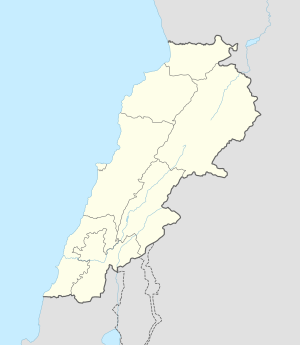Anjar, Lebanon
|
Anjar عنجر Անճար |
|
|---|---|

Ruins of the Umayyad city of Anjar
|
|
| Location in Lebanon | |
| Coordinates: 33°43′33″N 35°55′47″E / 33.72583°N 35.92972°ECoordinates: 33°43′33″N 35°55′47″E / 33.72583°N 35.92972°Eregion:LB_type:city | |
| Country | Lebanon |
| Governorate | Beqaa Governorate |
| District | Zahle District |
| Government | |
| • Mayor | [Vartkes Khoshian] |
| Time zone | EET (UTC+2) |
| • Summer (DST) | +3 (UTC) |
| Official name | Anjar |
| Type | Cultural |
| Criteria | iii, iv |
| Designated | 1984 (8th session) |
| Reference no. | 293 |
| State Party |
|
| Region | Arab States |
Anjar (Arabic: عنجر / ALA-LC: ‘Anjar; Armenian: Անճար French: Anjar, meaning "unresolved or running river"), also known as Haoush Mousa (Arabic: حوش موسى / Ḥawsh Mūsá), is a town of Lebanon located in the Bekaa Valley. The population is 2,400, consisting almost entirely of Armenians. The total area is about twenty square kilometers (7.7 square miles). In the summer, the population swells to 3,500, as members of the Armenian diaspora return to visit there.
The town's establishment is normally attributed to the Umayyad caliph al-Walid I at the beginning of the 8th century as a palace-city. However, historian Jere L. Bacharach claims it was al-Walid's son, al-Abbas, who was responsible for Anjar's founding circa 714 CE, citing the Byzantine Greek chronicler Theophanes the Confessor, who recorded that al-Abbas built the town. After being abandoned in later years, Anjar was resettled in 1939 with several thousand Armenian refugees from the Musa Dagh area. Its neighborhoods are named after the six villages of Musa Dagh: Haji Habibli, Kebusiyeh, Vakif, Kheder Bek, Yoghunoluk and Bitias. The Syrian Army chose Anjar as one of its main military bases in the Beqaa Valley and the headquarters of its intelligence services.
...
Wikipedia

